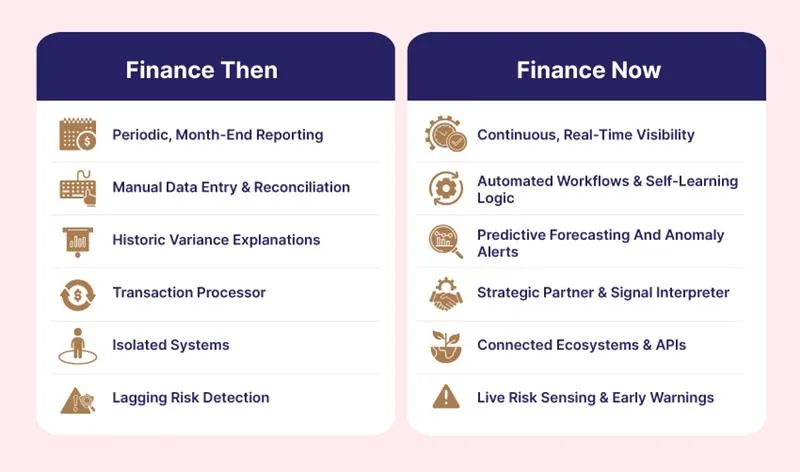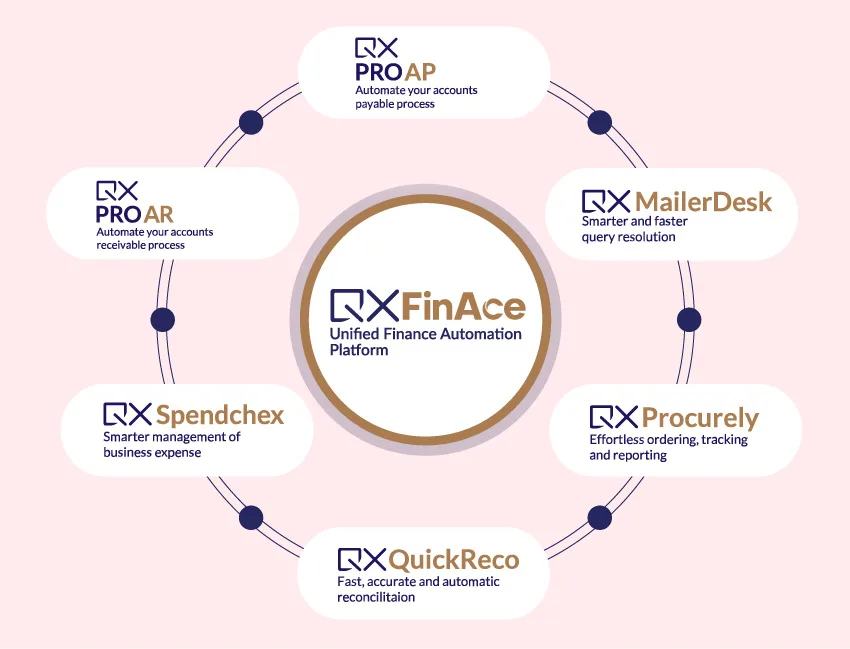
For years, finance was built on rigour and reconciliation. Collecting data, closing books, reconciling gaps, and reporting results. Accurate, structured, and always after the fact.
But the pace of business has changed. And finance must change with it.
Today, finance is expected to operate in real time. To anticipate outcomes. To guide decisions. And that shift, while quiet, is profound. It’s not just about faster processes. It’s about redefining finance itself, from a reporting function to a strategic partner.
This transformation is already underway, powered by AI, intelligent automation, and connected systems. Below are six key shifts we’re seeing, and what they mean for the future.
For decades, month-end was the rhythm that defined finance. A cycle of closing, reconciling, and reporting, only to start again.
That cycle is breaking.
Reconciliation can now happen continuously. Journal entries can post automatically. AI can scan and match transactions in real time. This creates a finance function that is always live, always ready.
The implications are significant. Decision-makers no longer wait for static reports. They operate on real-time views of cash, liabilities, and exposure. And the finance teams who once spent days closing books are now free to focus on analysis, strategy, and value.
This shift is not always loud. It’s not driven by sweeping transformation programs. It often occurs quietly through daily tasks that are becoming invisible.

If continuous accounting gives us the present, predictive analytics gives us the future.
Traditionally, finance has explained what happened. But with structured data flowing in real time, the question shifts from “What went wrong?” to “What’s about to change?”
Machine learning now helps forecast cash flow, surface risks, and spot trends before they appear in the books. These systems don’t just process data; they learn from it, and they do so at scale.
In one student housing portfolio, we helped restructure the reporting process. By applying automation, we reduced the close time from nine days to two. That freed up capacity for insight and accelerated decision-making.
The change isn’t just technological. It’s cultural. Finance is becoming a signal interpreter, not just a scorekeeper.
Finance no longer sits in isolation. It is deeply influenced by its surrounding systems: supplier platforms, customer portals, banking APIs, regulatory feeds, and operational tools.
This isn’t just about system integration. It’s about visibility and speed.
When purchase orders, expenses, and payments flow through one connected layer, finance stops chasing inputs. It starts guiding actions, approving faster, flagging issues earlier, ensuring compliance without delay.
We’ve seen this in practice. Platforms like QX FINACE integrate ERP systems, banking portals, and sector-specific tools to automate and unify finance functions. The result is a connected model where finance doesn’t sit at the end of the process; it shapes it as it unfolds.

Automation solved for speed. Autonomy solves for complexity.
Many repetitive finance tasks such as invoice processing, reconciliations, cash applications have already been automated. The next evolution is systems that learn.
Machine learning enables platforms to refine rules, manage exceptions, and adapt logic without manual intervention. Anomalies are no longer just flagged; they are understood in context.
In accounts payable, platforms like QX ProAP are already automating large portions of the invoice lifecycle, from ingestion and matching to exception handling. In high-volume environments, this reduces manual effort by over 60 percent.
The goal is not to replace people. It is to move them into work that adds higher value, such as strategy, planning, and decision-making, while systems manage the complexity.
Risk has traditionally been discovered after the fact. In missed payments. Liquidity shortfalls. Budget overruns.
That lag is no longer viable.
With the right data models, finance can sense risk upstream. AI can flag customer payment behavior that hints at emerging credit issues. Expense claims can be scanned for fraud signals too subtle for static rules. Real-time visibility into receivables and payables reveals stress before it becomes a crisis.
These systems don’t replace human judgment. They make it sharper, faster, and more proactive.
Finance, in this model, becomes an early warning system, not just a historian of missed signals.
Not all innovation arrives fully formed. Some ideas begin as small signals and take shape over time.
Decentralised Autonomous Organizations, or DAOs, represent one such signal. Originating in blockchain ecosystems, they hint at a future where governance and finance are embedded in transparent, rule-based, and self-regulating.
For finance, this opens up bold questions. Could reconciliations be self-executing? Could approvals be governed by smart contracts? Could certain policies enforce themselves automatically?
We are not there yet. But exploration has begun. The opportunity lies not in discarding structure, but in reimagining how trust, control, and collaboration could evolve.
As finance transforms, so too must our expectations of it.
Automation is no longer the end goal. Enterprises should look for systems that not only execute tasks but also learn, forecast, and offer guidance.
Finance should be judged not only by how accurate it is, but by how much it contributes. Did it forecast effectively? Did it support smarter decisions? Did it accelerate business outcomes?
Outcome-based partnerships, where value is tied to measurable impact, are becoming viable. Technology is making performance more transparent. And finance has a new seat at the table.
It is no longer just a service function. It is the intelligence layer of the enterprise.
This transformation is real. It may be quiet. But it is reshaping the role, reach, and responsibility of finance.
At QX, we are building for this future. Through platforms like FINACE and ProAP. Through the work of our AI Labs. And through QX AI Mastery, our internal learning pathway designed to equip our people for a world where finance leads, not follows.
To every client, partner, and team member driving this change, thank you.
We are not simply modernising finance. We are reimagining what it can become.
And we’re just getting started.
For more information, please contact Mandar Vanarse, Chief Technology Officer; Mahesh Jain, CEO – QX F&A Services; or Jignesh Gohil, VP – Software Services.
Visit QX F&A Services to explore our suite of finance and accounting solutions. Learn how we’re helping businesses of all sizes simplify operations, reduce costs, and unlock new levels of efficiency and strategic advantage through technology and expertise.
Talk to our experts to identify the right AI strategy and tools for your business.
QX Global Group will use your information to contact you regarding new blog posts by email. You can unsubscribe from it at any time! For more information, check out our privacy policy.
Let’s explore how our AI-powered solutions can simplify, streamline, and scale your processes.
QX Global Group will use your information to contact you regarding new blog posts by email. You can unsubscribe from it at any time! For more information, check out our privacy policy.